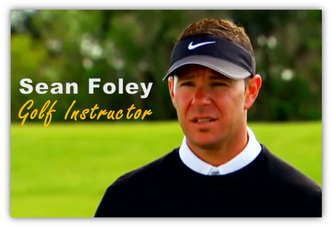 You can't help but admire professional golf instructor Sean Foley and the amazing work he has done with some of the best golfers in the world including none other than Tiger Woods, Justin Rose, Hunter Mahan and Lee Westwood. Recently he was interviewed by legendary interviewer Charlie Rose and we wanted to share the interview with you so you could gain some insights into how Sean Foley works with his professional golfers. We hope you enjoy it and if you feel so inclined we would like you to share your views on the interview as we are always interested to know what you think. Enjoy the interview and thanks as always for supporting us. Lawrie Montague and David Milne - Pro Tour Golf College Your Success On Tour is Our Business "I had a chat with Lawrie, saying how I've never had so much difficulty hitting this little number of golf balls before. He then explained to me that this is exactly how we were going to train throughout the rest of the program, and that this was already going easy on us! As he explained more, everything started to make sense." 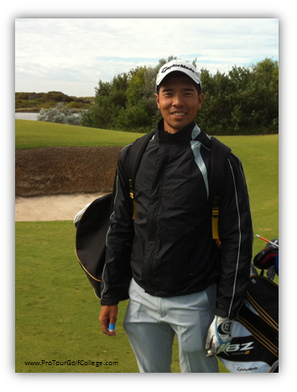 I'm Ian, currently a student doing my first semester with Pro Tour Golf College. I'm here to share a bit about my first week at PTGC, but before I go into that, here's a little background information about myself. I'm from Singapore and have been playing golf for 19 years, never had a lesson and instead learnt most of my golf from a Jack Nicklaus book, along with countless tips from anyone and anywhere. I managed to practice my way to a single handicap, and eventually became a member of the Singapore PGA. After spending several years teaching, I decided to give up coaching and give competitive golf a shot, so here I am. So, down to the gist of it. Assessment Week or "Hell Week" at Pro Tour Golf College Assessment week was pretty grueling (that's an understatement) - 770 shots from all sorts of lies and distances, all requiring a full pre-shot routine. Having to maintain focus at a high intensity for 6 hours a day is no easy feat, but after five days of having given it our all, it was finally over. Going through the full assessment gave me great insight on the strengths and weaknesses of my game, but more importantly it taught me about the teaching philosophy that is Pro Tour Golf College.  The 3rd Hole Quarry 9 Joondalup Resort home of PTGC The 3rd Hole Quarry 9 Joondalup Resort home of PTGC Being a touring professional is a job, and a difficult one at that. As such, we should structure our training like how we would run a business. Nobody with a right business mind would say "okay let's just order this amount of X and that amount of Y, and hopefully we will be able to sell them all." There would be so much more planning involved, so much more to factor in. "What is the market demand? Is the demand seasonal? How much competition do we have? What is the size of our target audience?" Business is not my strongest point, but even I would not want to step into any venture without having explored every factor involved in achieving success before I pump my money and effort in. Why shouldn't it be the same in golf? "I grab 300 balls from the dispensing machine, do a quick warm-up, then proceed to hit balls, working my way up the bag. If I hit a good shot, yippee good for me! " 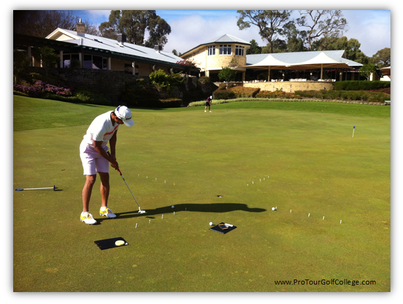 I have always been hard-working when it comes to sports. I would hear of how Vijay or Ben Hogan train, spending hours and hours hitting hundreds of balls every day, and my mindset was that if I do that too, I would somehow find "the secret in the dirt" eventually. I knew my short game was weak, so I just need to dedicate more time chipping, pitching and putting. I grab 300 balls from the dispensing machine, do a quick warm-up, then proceed to hit balls, working my way up the bag. If I hit a good shot, yippee good for me! If it didn't turn out the way I wanted it to or hit a bad shot, I'd try and figure out what was wrong, dedicating the next few shots towards rectifying the problem. This was the same for chipping and putting practice. My practice routine was formless, and did nothing to prepare me mentally for a round of golf. As I went through assessment week, our coach Lawrie kept reminding us to take each shot as if it was on the golf course, making sure to give each and every shot our full attention. Needless to say, at the end of the first day after going through 280 balls in this manner I was knackered.  I had a chat with Lawrie, saying how I've never had so much difficulty hitting this little number of golf balls before. He then explained to me that this is exactly how we were going to train throughout the rest of the program, and that this was already going easy on us! As he explained more, everything started to make sense. On the golf course, we have one shot. Regardless of whether we hit it well or not, that moment is gone. We don't have mulligans to rectify our mistake, and our next shot is not (hopefully) going to be in the same place that we would hit the same shot again. That point in time is over, and we have to let it go and embrace the new reality, the new challenge before us. It is the same with how we train: it is not a cluster of balls we are hitting - it is one ball. And then another. And another, do that ten times, take a short mental break, then move on to the next ten balls, but one at a time. Whatever happens to the ball, embrace the result, then let it go as you move on to the next. Also, having the training structured like this conditions us to learn how to sharpen our focus when we step up to the ball, and giving our mind a break every now and then. My training used to be pretty monotonous; it was just ball after ball and never really trained me to switch off and on, such that I was not very good coping with my mental stamina. "Everything from now on has to be planned. I have learnt so much within such a short amount of time, and this is the beauty of this program - we aren't taught how to play golf, we are taught how to learn."  Lastly, the assessment covers a huge variety of shots, such as chips from 10-30 metres, flop shots from 10-30 metres, putts from 1-14 metres, buried bunker shots and rough shots from 10-30 metres, approach shots from 30-90 metres, and full shots from 90 metres onwards. Every category's scores is recorded and mapped out on a chart, where I got to see exactly which areas in my game were lacking, also allowing me to compare my stats with the tour averages. I came in with the pre-conceived notion that my short game was very weak, but after the assessment I found out that some parts of my short game were actually not that bad, for example:
However, it became very obvious that I needed to work on my putting across the board;
If I hadn't known this, I'd probably still be spending a lot of time working on areas that aren't on the top of the priority list. With this, I have learnt to take responsibility for my training. No more random or mindless practice sessions, no more second guessing. Everything from now on has to be planned. I have learnt so much within such a short amount of time, and this is the beauty of this program - we aren't taught how to play golf, we are taught how to learn. Ian Sim - Student at Pro Tour Golf College Recently I attended an international psychology conference held in Singapore centered on the themes of motivation, self-concept, and identity. Conference goers included Psychologists, Coaches, Researchers, and Educators. Keynote presentations were given by professionals at the top of their field on a world stage. Here are some interesting take home points for those in the business of high performance and individuals striving for excellence, and looking to develop their full potential.  Richard Ryan, the world leader in research on Motivation Theory from the University of Rochester, spoke about coaching and high performance and how to build sustainable forms of motivation.
The key to cultivating Intrinsic motivation is to create habits around the following thought processes and actions on a daily basis:
o Allow for structured self-reflection time that helps you to develop meaningful choices each and every day. This will transpire into meaningful, “purposeful” training habits. o Reduce comparison to others and instead focus intensely on crafting your own path and targets. o Emphasise a focus on mastery of skills, method, and strategy toward success, rather than a primary focus on scores and results. o Have regular discussions with your Coach or Sport Psychologist about your strengths as a player and a person, and create opportunities to utilise them.
o Creating a motivation for high performance solely around regulatory rewards such as, money, fame, or approval from others should be avoided. These sources of motivation can propel individuals to work intensely on occasion; however, these factors should only be seen as secondary sources of motivation called upon from time to time. Unless you are constantly receiving such rewards ALL the time, this form of motivation cannot be sustained and you are likely setting yourself up for tremendous pressure or disappointment.  Felicia Huppert, Director of the Centre for Positive Psychology and Education from The University of Western Sydney presented on skills for well-being that should be a part of our everyday awareness. Huppert currently leads a program designed to train “Mindfulness” skills for enhancing concentration and awareness. · Huppert’s research shows that when individuals experience positive mood in the learning environment they not only generate significantly more ideas but those ideas are far more creative and original. · Huppert concludes that creativity is important for learning and fostering intrinsic motivation. · Great coaches are creative in their approach. In applying these findings to your own game, don’t let strict routine stifle your creativity. Allow for structure and reason but be creative in your approach to training on the course and in the gym every so often. This will inspire insightful brainwaves and planning. Life-Satisfaction Huppert introduced the key ingredients to life-satisfaction with reference to the work of influential researcher and author of “Authentic Happiness”; Martin Seligman. Seligman’s research assessed countless psychosocial factors to deduce FOUR key ingredients to life-satisfaction, which he refers to as the “PERMA” model. Positive emotion Relationships Meaning Accomplishment In order to cultivate the PERMA model in your life focus on these five simple yet crucial approaches to enhancing well-being: · Connect · Be active · Take notice – reflect/ be aware/practice focused breathing or meditation. · Give · Keep improving One Step Forward: Identify ONE approach from the list and create ONE new opportunity to focus on this well-being shaper in your life or work TODAY. If you would like to learn more about how to craft your individual strategies in the pursuit of excellence in career or life, a Mental Notes Consultant is here to help. 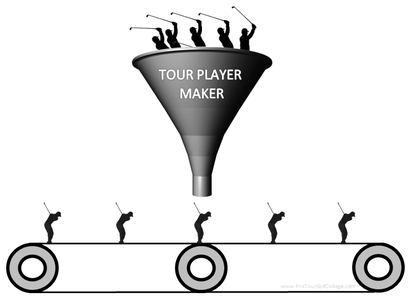 Can you imagine spending between $14,000 and $18,000 dollars just to play a marathon 306 holes of pressure packed competitive golf against hundreds of other golfer for a chance to win one of fifty cards? Hundreds of ambitious and highly skilled golfers definitely are willing to try, especially at this time of the year when they make the annual pilgrimage to PGA Tour School to try their luck and skill and gain a card to play next year on the Web.Com golf tour - The pathway to the PGA Tour. Sadly the truth is that nearly all of them won’t be good enough to go through the pre-qualifying, let alone the first, second and final stages and go on to gain their Web.Com tour card and here's why. Tour School is a Cash Cow PGA Tour's around the world make millions of dollars conducting tour schools every year and are a major source of revenue for them. They know that the reality is that most of the golfers competing will not be good enough to get through the qualifying process and will basically donate their significant tournament entry fees in their effort to live the dream of playing golf on a professional golf tour. Beginning with the first stage about 750 golfers competing at 12 venues around the US (including first stage qualifiers) will pay entry fee’s to play first stage of between US $4,500 to $6,000 (depending on when you pay) and exemptions are offered to golfers with specific standing on several of the world’s leading men’s professional golf tours, and also those with PGA Tour, Official World Golf Ranking, national PGA club professional, Walker Cup, U.S. Amateur, previous qualifying tournaments and other standings. See http://www.pgatour.com/webcom/news/2013/06/26/qualifying-tournament.html  So just to be clear up front, the minimum requirement for you to even consider going to Web.Com tour school is an ability to score par or better in bigger amateur golf tournaments or professional tournaments on championship layouts at least 70 percent of the time over at least one season. And your high score average (C game average) should not be higher than plus 3 to have any chance at all of making it through the qualifying stages. If you can’t manage this standard just yet then don’t even consider it because it costs an awful lot of money in entry fees, travel, hotel and meals and you won’t make it through. Why? The odds are heavily stacked against you making it if you have little to no experience in this type of competitive environment. Only the most experienced or highly skilled - low scoring golfers make it through to the final stage. How to Get From 750 Golfers to 144 As I mentioned if you have no status as an amateur or professional then you will have to pre-qualify just to get into the first stage and your score average will need to be no higher than two over par for each of the three rounds you play to get through to the first stage depending on the venue you compete at. This year’s pre-qualifying route to the Web.Com Tour is a case in point where pre-qualifying eliminated many golfers before the first stage. There were 465 golfers in the pre-qualifying tournaments competing at six golf courses around the US with about 226 places plus ties getting through to the first stage. Entry fees were US $2,700 to try and make it to first stage.  That’s about fifty percent of the golfers that moved on to the first stage to join golfers who had some sort of status and were eligible to start at first stage. Just to give you an idea of the types of golfers competing in the pre-qualifying event the winners over three rounds shot between 7 and 17 under par, and the highest scores in the field ranged from 31 over par to 72 over par. You needed to score from even par to plus eight depending on where you played to gain a place in the first stage field. At the first stage you will are competing with about another 270 golfers I’m sure you can see that the PGA Tour has no choice but to keep eliminating golfers until the final stage because there are only 50 cards on offer to play on the Web.Com Tour next season. First stage sorts out golfers (just as the pre-qualifying did) that are simply not good enough, or are not having their best week on the golf course. To make it through first stage you’ll need to score around par or better for four rounds to make it into the second stage and now you will have played 7 rounds (assuming you pre-qualified) and your score average will need to be close to par or better to continue on. In the second stage you’ll pay more entry fees (yep you keep paying) of between US $4,000 and $5,000 and just like the first stage you’ll play another four rounds and now you’ll have to score better than par to make it to the final stage. By now you have played 11 rounds and I think you can see what’s happening here. The tour is sorting out those that can really play from those that can’t because they want the very best golfers competing in their Web.Com tournaments. In the final stage about 144 golfers compete over six rounds of golf (a total of 17 rounds or 306 holes if you started from pre-qualifying) and 14 rounds or 252 holes of golf if you started from first stage and you will definitely have to score well under par (likely 10 or more under par) for the six rounds to have a chance of getting one of the 50 cards on offer. Entry fees for final stage are between US $3,500 to $4,500 depending on when you pay and at the final stage there is some prize money to play for.
Here's the facts if you started at the pre-qualifying stage and are good enough to make it to final stage:
This is the harsh reality of becoming a tour professional on the Web.Com Tour and it is really no different for any other major men's or women's golf tour that you attempt to qualify for. So what does it really take to play for pay on a professional golf tour? Well now you know. The best of luck to you. Lawrie Montague and David Milne - Pro Tour Golf College Your Success On Tour is Our Business Picture this if you will; it’s a Thursday, 9.45 in the morning and the suns shining, it’s warm, and you are standing on the driving range at your club on the far right hand side of the grass tee where you like to practice.  You drag another golf ball over from the pile of 100 practice balls that you purchased from the pro shop at 9.30 and you place it onto a nice piece of grass right next to your last divot. You are using your 6 iron and hitting shots at the 175 yard target marker in the middle of the range. You do this most days and your goal is to hit your 6 iron as close to the target as you can. After you hit your 6 iron and you’re satisfied with your results you will hit some 3 irons and then you'll hit some drivers at the 250 yard marker because it has been giving you some problems on the course. Later when you finish your practice balls you will then hit some putts on the putting green in front of the clubhouse and then go out for 18 holes with your friends at 12.15. Does this sound vaguely familiar? Maybe it does and maybe it doesn’t, but you can be sure of one thing, this type of approach to golf practice is pretty common. Why? Practice Without a Plan - The Perfect Way to Fail One of the consistent problems that David and I have witnessed countless times over the years is elite amateur golfers and professional golfers executing daily golf practice routines with little to no direct relevance to improving their performance on the golf course in the long term.  In others words, the drill or practice routine does not connect them to their longer term goal. Can you imagine putting hours and hours into your game only to discover that what you were working on did not and would not improve your golf score average when you compete? This is still one of the biggest problems in elite level golf as we see it, and sadly it doesn’t look like changing anytime soon. Drills and Skills Without a Destination When you practice your golf skills you must have a well thought out plan that links your current practice effort to some pre-defined outcome. Otherwise, what is the purpose of your golf practice? You're just spinning your wheels. In my last article I shared with you that the leading tour players on the major golf tours now use analytics experts who help them to understand what they need to work on to improve their golf performances on the golf course based on carefully evaluating their golf course statistics. Why do you think the best players in the game are doing this? The answer is pretty simple; they want to know that what they are working on - and applying their best effort to is correct! And so should you. How do you know that the drills or practice routines you are using currently are the correct ones for you? Imagine for just one moment that they’re not! What are you going to do about it?  Golf Performance Progress Goals If you are a serious golfer who wants to achieve a lower scoring average then you really have to take a good look at what you are doing right now when you go to work on your game. This is where golf performance progress goals are incredibly useful. Golf performance progress goals are exactly as they sound; Golf-Performance-Progress-Goals. They are short-term goals that help you to bridge the performance gap and require an understanding of what you need to practice, and also how much practice you need to do (within a defined timeline) to help you to achieve the performance goals that you have established. Remember in the last lesson we discussed three types of golf performance – goal types for advanced golfers? They were; 1. Golf shot (ball flight) goals 2. Golf stroke (technique) goals 3. Golf score (metrics) goals Deciding what to work on is really important here, because it will be difficult to improve your performance on the golf course if you pick the wrong category to work on. In the last lesson I showed you an example of a performance goal of achieving a 75 score average.  Break the Goal Down Say that your current score average is 77 which when divided by 18 holes works out to be about 4.27 strokes per hole. A 75 score average is 4.16 strokes per hole, the difference between the two being just 0.11 strokes per hole improvement. Doesn't seem like a lot does it? What would you need to do to improve your chances of improving your per hole stroke average of 0.11 over 12 months?
These are the type of highly specific and important questions that you need to ask yourself to ensure that what you are practicing every day is relevant and moving you towards your performance goals.  Measuring Goal Progress The next helpful question is how will you measure your progress along the way? This is also an important question and forms the basis of developing and implementing golf performance progress goals. When you practice to improve your performance it will be helpful to decide how you measure your progress along the way. Ball Flight Goals: You can measure your ball flight consistency by measuring how effectively you can control;
By creating a simple table like the one I've designed below will help you track and record the practice shot information very easily and by using a simple code you can easily monitor your progress and manage your practice effort effectively. Basically you design the type of shot you wish to hit (with the help of your golf instructor), like a medium height draw shot that starts on line. You measure the quality of each golf shot and you use the matrix (below) to help you to measure and manage the type of golf shot that will help you to achieve a consistent ball flight. Your golf instructor will be able to help you to stay on track with your goals more easily using this simple approach because you are getting accurate feedback every time you practice using this simple method of data collection. Alternatively if you have access to Trackman or Flightscope technology you could measure ball flight this way. **Remember with this strategy you are measuring the quality of the golf shot execution NOT the quality of the golf stroke. Golf Stroke Goals What about your golf stroke technique? How would you measure improvement here? If your golf instructor has a 3D system you could measure your stroke improvement using a high tech approach, but what if you don’t have access to this type of technology? Is there another way? There is! You can isolate the part of your golf stroke technique that you wish to improve and track your improvement using a simple drill sheet where you rate the quality of each stroke against a standard that you define with the assistance of your instructor. The first thing you will need to do is discuss with your golf instructor exactly what part of your technique needs to be improved and the type of drill or practice routine that you will employ, as well as the time line for achieving the change. Using our stroke improvement matrix will help you to stay focused on the purpose of your drill or routine and also accelerate the change process because you are tracking each set of golf shots against the standard that you have established. Basically you rate each set of 10 golf strokes you perform on a scale of 1 to 10 from not yet competent through to learned. Your ultimate objective is to consistently rate in the 7 to 10 range where you have attained a level of unconscious competence over the drill / skill or routine. **Remember with this strategy you are measuring the quality of golf stroke technique execution NOT the quality of the golf shot. Golf Score Goals Maybe your shot-making and techniques are really sound and you don’t have to do a lot of work in these areas but you need to be able to monitor your performances from round to round and establish benchmarks along the way. It is surprising to us how many tournament professionals aren’t tracking their numbers to understand where they are with their game. If you have a score average in tournaments of 72.0 and you are missing 50 percent of cuts in a year then it makes good sense to start monitoring your scores carefully to identify the weakest-most important elements of your game that are keeping your average higher than you want it to be. Lowering your score average from 72.0 to 71.5 (half a shot) over 12 months would do two things. 1. You would make more cuts in a season 2. You would earn more income Tommy Gainey’s score average in 2013 on the PGA Tour was 71.99 (actual) for 84 rounds and he made 14 cuts from the 28 tournaments (50%) he played and earned $520,479. D.A Points played the same amount of events as Tommy Gainey in 2013 but his score average was 71.46 (actual) a difference of .53 strokes per round and he earned a whopping $2,658, 887, a difference of $2,138,408 dollars. If you were Tommy Gainey I bet you would be studying the numbers carefully to identify the areas of your game that need some improvement. Interestingly D.A Points cut average was only slightly better 15 cuts made from 28) than Tommy Gainey, but he produced a lower score average for the 15 tournaments he played all four days in. If you were to choose one golf performance progress goal from the list below that linked directly to the performance goal you’ve chosen, which goal would it be? Using our example below we listed five performance goals and I want you to think about how you would measure performance in each of them over a defined period of time. Golf Score Forecasting Model The simplest way to measure your progress towards a goal (like achieving a 75 score average) is like this. Let’s say that your current score average in December is 77.0 and your goal in 12 months is to achieve a 75.0 average, the formula for working out is really easy. 77.0 minus 75.0 divided by 12 months equals 0.166 strokes per month. So the January target would be 77 minus 0.166 (rounded off) which is 76.8. You follow this simple formula for each month and you will end up on the number in 12 months. Now this doesn’t mean that it will miraculously happen without a plan for improvement, but it will certainly help you to stay focused on the progressive realization of your goal. Ok, so how will you measure your golf progress performance goals now that I have given you some strategies? Take out your goals notebook and write in your number one golf performance progress goal. Write it just like I have in the example below and then do the same for the rest of your golf performance progress goals. So there you have it. You now have a useful way of measuring your progress towards your goals.
Since our first article we have traveled on a journey from the end of your golf career to the beginning and along the way you have committed yourself to designing your ideal golf career using your goals notebook. Give yourself a slap on the back and WELL DONE! Sadly the majority of advanced and elite amateur and professional golfers don't have a goal plan, only a bunch of weak wishes, and you now have a document that will guide you carefully and safely along your performance pathway to golf success. Remember that nothing is set in stone and you can change the goals as you need to and refine your goal process for achieving them. We wish you the very best with your journey and if we can help you in any way please don't hesitate to contact us. Lawrie Montague and David Milne - Pro Tour Golf College Your Success On Tour is Our Business 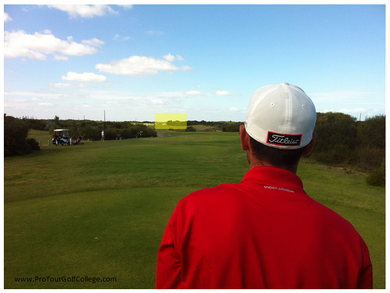 You're a serious golfer. We are certain that you are, and our articles are deliberately written to show you how you can be the best golfer you can be. You know and understand the importance of a good pre-shot routine that helps and supports you to produce good quality golf shots under pressure in training, and then transfer it into tournaments. Now I am not talking about the physical pre shot routine (which is important) but the mental pre-shot routine which is absolutely critical to get into the "flow zone" to execute consistent golf shots. If you're working on breaking a scoring barrier like 80, 75 or 70 you better be working on having this part of your game in place. Otherwise you will end up being able to execute good shots on the driving range but when it counts on the golf course you will struggle to produce the shot that you want. You're not alone, and I will help you get an understanding of how to go about establishing a good mental pre-shot routine. All successful golfers have a mental pre-shot routine that has been practiced over many years and the have full trust in it - no matter what the situation is and when. The more simple you keep it, the better the chance you have of repeating it. In my experience you only have to do three things consistently to develop a world class mental pre-shot routine. That's right just three things! THE SEE IT - FEEL IT - DO IT STRATEGY You have probably read and heard that using your preferred learning style (visual, kinesthetic, auditory) is essential for learning effectively and whilst this is true from my experience working with hundreds of elite golfers over more than thirty years I have found that using all your senses together works best in developing an effective mental pre-shot routine that works. 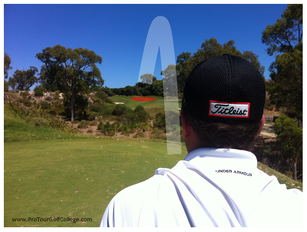 1. SEE IT The start of your mental pre-shot routine begins after you have completed the planning of the golf shot and selected the club for the shot and you are standing behind the ball looking toward the target. You have done the planning stage, now visualize the trajectory and shape your're intending. Program and see what you want to achieve as opposed to what most people do and focus on the shot they don't want to see. Is this you? If you have selected a shot that you are not confident with you will be thinking only of the technique required to execute the shot rather than seeing the shot and removing analytical thoughts that interfere with the successful execution of your golf shot.  2. FEEL IT If you take practice swings, just before you walk in is the place to do this. If your preference is not to have a practice swing then that's not an issue as long as you have clarity and can see the shot you want to execute. As you walk in and take your address posture internalize the feel through out the body and where your balance is by focusing on being able to "center" yourself. You will have observed athletes especially martial arts experts getting into a centered posture before they execute a movement, or a set shot like in tennis (serve), basketball (free throw), soccer (penalty). By learning how to breathe properly this will help you center yourself as you address the ball and also reduce the negative self talk that tends to surface at this point. 3. DO IT Once you have centered yourself one last look at the target and as you eyes track back to the ball the clubhead is starting the backswing and you're in the "Flow Zone" and on your way to improved ball striking under pressure when it counts. Use this information to design your own simple 3 step mental pre-shot routine, and you will be well on your way to lowering your competitive score average in no time. David Milne and Lawrie Montague - Pro Tour Golf College Your Success On Tour is Our Business The E.G.I.S Program is The Most Comprehensive Golf Training Program for Serious Golfers in the World. Don't Believe Us?...24 HD Golf Instruction Videos (Over 4 Hours), 10 Golf Training Templates and an 88 Page Training Manual Showing You Step-By-Step How You Can Practice Golf to Learn How to Break Par All This For Only $97.00"The lines are so thin (between a good and great season), so I’m trying to find any edge I can get, Mark’s done a great job for me of understanding who I am as a golfer. 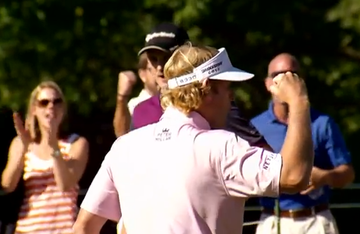 Mark Horton is Brandt Snedeker’s numbers guy on the PGA Tour who trawl’s through and analyses Snedeker’s ShotLink data to determine the areas of his game he should work on to improve his performances on the golf course. This information is then built into a strategy of how he will play a particular golf tournament from the point of view of managing shot selection and strategy, through to specific performance objectives like a tournament score goal that he will aim to achieve. Since Snedeker began working with Mark Horton in 2010 he has greatly improved his performances on the golf course. Read this Golf Digest article: http://www.golfdigest.com/golf-tours-news/2013-09/gwar-golf-stats-rosaforte-report-0930 High level golf performers like Brandt Snedeker and other PGA and LPGA tour professionals use golf performance metrics today more than ever to help them understand what they need to do to become more successful on the golf course. Since there is nothing you can do about the way another golfer is playing, all you can really do is concentrate on your goals for an event and have an effective and well thought out strategy in place to maximize your performance. Performance goals are the short-term goals that help you to do this. What are Performance Goals? Performance goals are the next step in the goal building process where you now identify specific performance objectives in the short-term like shot type goals such as learning how to hit a punch shot, or possibly golf stroke type goals like learning an advanced bunker shot technique, or even golf score goals like achieving a certain score average. So let’s have a quick look at what your goals look like so far. You should now have your career goals and relatively long-term goals written in your goal notebook, and now we’re going to add the shorter term performance goals that help you link the whole process together. When you think about goals, Earl Nightingale was right when he said that goals are “the progressive realization of a worthy goal or ideal.” Goals, whether they are short-term goals like performance goals, or far away goals like career goals, really are all about being able to see your ideal future, and have a big enough reason to pursue them. Golf is a numbers game, let’s not forget that, and your performance goals drive the process that leads to the achievement of worthwhile outcomes like a low scoring average for the season, or possibly a golf stroke goal like improving your putting average from 6 feet (2 metres), or even goals like improving your proximity to the hole from bunkers. Your performance goals are chosen by you, however you will find it extremely helpful to involve your golf instructor/coach in this process to help you to decide which performance goals are the right ones for helping you to make progress with your game. And that’s the name of the game after all, isn't it? The criteria for selecting your performance goals will be based on the model we presented to you earlier, and in this case you will be using four of the goal selection criteria to help you to select your most appropriate goals. So to help you to understand how this works, let’s use the example of winning the under 18 state golf championship to show how to identify your performance goals. If you wanted to win the under 18 state golf championship (insert whatever your most important year one goal is) what would your playing standard need to be to give you the best opportunity to achieve this goal? Here are some helpful questions that will aid you in getting some clarity around achieving this goal. 1. What would your score average need to be? How else could you define your playing standard? 2. What specific golf techniques would you need to improve? 3. Are there any particular golf shots that you will need to be develop with your golf instructor to play the golf course in such a way that you would improve your opportunity of winning - or at the very least contending in the tournament? These questions will help you to get started. Notice that in order to give yourself the best opportunity to win this event you need to get your score average or playing standard to a range that would improve your odds? That's logical enough isn't it? As I’ve mentioned previously, if you don’t establish a score standard, how can you achieve any of your goals in the short term or the long term?  Now we need to identify the most important performance goals that will help to make progress towards your relatively long-term goals. Remember the sequence as you go through this exercise. What would come first? For example if your goal was to win the under 18 state golf championship what would be the first thing you would have to do? What’s would be the next step and so on? Here’s an example (below) of how to write your performance goals down in your goals notebook. And remember to make sure that as you write these goals, you write them positively. Take your time thinking carefully about your performance goals, and it wouldn’t be a bad idea to ask your golf instructor to assist you with this exercise. Now it’s your turn, write down ten or more performance goals and keep in mind as you write that these performance goals can be very short term performance goals (weeks) through to longer term performance goals (months).  Narrowing Your Focus Next, I want you to go back through your list of performance goals and choose the five most important performance goals out of your list and rank each of them from most important to least important and then put a circle around them or highlight the category to the right of your goal that represents the type of performance goal it is.
Remember to maintain balance in setting your performance goals. How does your shot-making or stroke-making influence your score-making? If you wanted to achieve a score average of 75.0 what skills/shots directly influence you achieving this performance goal? Will you need to improve existing golf techniques or your shot-making to achieve these? Your ranking is going to be based on the order of relevance and their influence on achieving your most important performance goal. Here's an example of a re-rank for the five most relevant goals that will give you an idea of how its done. The 5W-1H Strategy Once you have written out your five re-ranked performance goals (as I've done in the example above) now you need to add your reason or justification for achieving each of them. You will find it helpful to use the 5W - 1H Strategy for writing out each performance goal you've chosen as this strategy will help you to justify your reasoning for choosing each of your performance goals. Once you have written (in pencil) your performance goals, go over them carefully and make sure that you are happy with your selection. 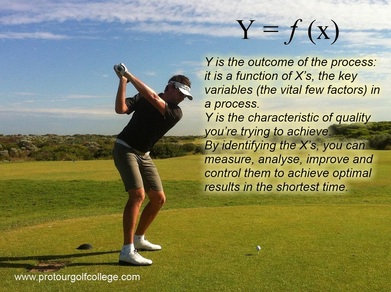 Find the X's in Your Game The best golfers in the world are now getting help from experts in fields other than from golf instructors and sports psychologists to help them achieve their goals in tournaments. You need to be able to break down your performances carefully to identify the skills and strategies and numbers to help you make progress with this challenging game. The formula Y = f (x) in the image left comes from Six Sigma which is a business management strategy originally developed by Motorola, USA in 1981. This formula perfectly describes the inputs, outputs, and the variables that influence your golf performance outcomes. -------------------------------------------------------------------------------------------------------------------- Here are the links to three comprehensive golf statistics programs that we highly recommend. (We don't receive any compensation for recommending these golf statistics programs, we just think that they are great programs for serious amateur and professional golfers and worth a look.) http://shotstohole.com/ http://www.shotbyshot.com/ http://www.golfdatalab.com/ -------------------------------------------------------------------------------------------------------------------- Goal setting is all about getting the process right at the input side so that the outcomes are consistent with your expectations. Your job is to continue to identify and improve the 'X's in your game so you can make steady and continuous progress. “Whether he helps or not, I think he does and I believe he does, so that’s all that really matters, I've got confidence in what he tells me. He’s turned into my mental guru, I guess. He gives me peace of mind in what I’m doing.” - Brandt Snedeker talking about Mark Horton In the last part of our goal building process I will show you how to use Performance Progress Goals to really narrow down your goal process to the actual practice processes that will help you to achieve your performance goals.
If you are thinking that goal building is quite an involved exercise, you would be right. But remember this;
Yes they worked hard, but they also knew exactly what they wanted. Goals take the question mark out of your future in golf (or anything else) and replaces the question mark with the specific steps to a better and more successful life. Lawrie Montague and David Milne - Pro Tour Golf College Your Success On Tour is Our Business |
Archives
June 2019
|
Proudly Supported By
Copyright © 2011 - 2018 Pro Tour Golf College
Website Managed By Golf Performance Media
All Rights Reserved
Website Managed By Golf Performance Media
All Rights Reserved



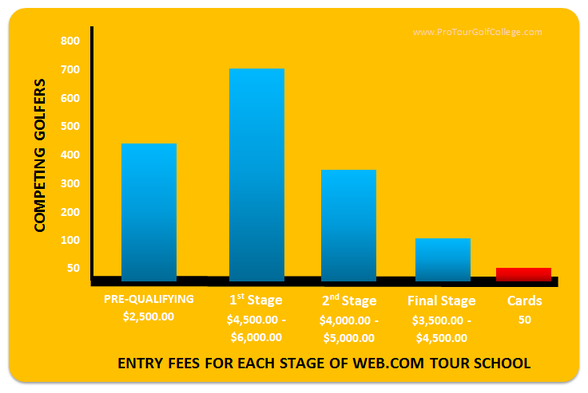


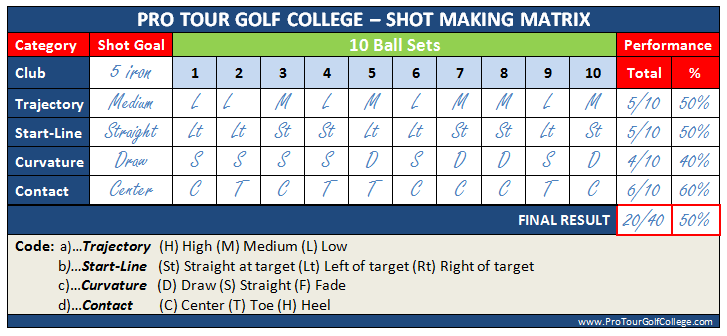








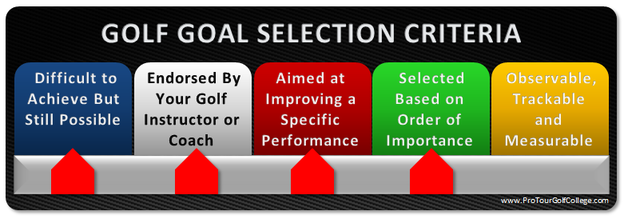





 RSS Feed
RSS Feed



